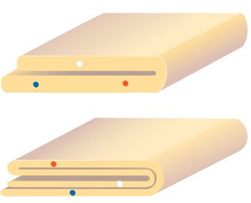
Making dough. Many delicious French desserts, such as Napoleons, are made of numerous thin layers of pastry. Once upon a time a French chef began, as usual, to make a masterpiece with a segment of dough one unit long. This time, however, he noticed that three grains of colored sugar-one red, one white, and one blue-were embedded in the pastry. He stretched the dough to twice its length and then folded it in half to produce a double layer of thinner pastry still one unit long. He again stretched the dough to double its length and, folded it to produce four layers again one unit long. He repeated, the process: stretch to twice its length, fold to produce eight layers. He stretched and folded again and again. As our chef stretched and folded, he became fascinated with the movement of those three grains of sugar. In fact, he noticed that the red grain always returned to its original location. The white grain began somewhere, went to a different location after a stretch and fold, and then returned to its original location after one more stretch and fold. The blue grain rotated among three different places. The chef was so fascinated with the infinitely recurring itineraries of these grains of sugar that he stretched and folded the dough to such an extreme thinness that his dessert creation lived up to the high expectations for light, puffy French desserts and became the Napoleon of pastries.

Want to see the full answer?
Check out a sample textbook solution
Chapter 7 Solutions
The Heart of Mathematics: An Invitation to Effective Thinking
Additional Math Textbook Solutions
Intro Stats, Books a la Carte Edition (5th Edition)
Basic Business Statistics, Student Value Edition
Precalculus
Elementary Statistics
Elementary Statistics (13th Edition)
STATISTICS F/BUSINESS+ECONOMICS-TEXT
- Prove by mathematical induction that for any positive integer n, the sum of the cubes of the first n natural numbers is given by: n Σκ k=1 (n(n + 1))²arrow_forward1 L'Ina (ln x) 2020 dx 0arrow_forwardCalibri BIUAAAA ויו Text in Italian is not being checked. Do you want to add it as a proofing language? Task 12 Fig 1 75 75 75 Fig 2 Fig 3j Add Figures 1 to 3 each shows a top view and a front view of models. Make use of the lineated paper for isometric projection and take each block on the paper as being 10mm x 10mm. Use the indicated sizes and draw an isometric view of each of the three models Samsung Galaxy A04earrow_forward
- a) show that the empty set and sigletonset are convex set. 6) show that every sub space of linear space X is convex but the convers heed not be true. c) let Mand N be two convex set of a linear Space X and KEF Show that MUN is conevex and (ii) M-N is convex or hot A and is MSN or NSM show that MUN convex or not, 385arrow_forwardxp x+xarrow_forwardFor the given graph, determine the following. -3 12 УА 4 3 - -1 ° 1 2 3 x -1. -2- a. Determine for which values of a the lim f (x) exists but f is not continuous at x = a. a b. Determine for which values of a the function is continuous but not differentiable at x = a. aarrow_forward
- I write with prove one-to-one linear Sanction but not onto Lexample.) b) write with Prove on to linear function but not oh-to-on (example). c) write with prove example x=y St Xandy two linear space over Sielad F.arrow_forwardUse the following graph of ƒ (x) to evaluate ƒ' (−1) and ƒ' (2). y +10+ 9 8 7 6 5 4 3 2 1- -10 -9 -8 -7 -6 -5 -4 -3 -2 -1 x 3 4 0 8 9 10 -2 3 -4 5 -6 -7 -8 -9 -10- f'(-1)= f' (2)arrow_forwardFor the following function f and real number a, a. find the slope of the tangent line mtan = = f' (a), and b. find the equation of the tangent line to f at x = a. f(x) = 2 = ;a=2 a. Slope: b. Equation of tangent line: yarrow_forward
- For the following function f and real number a, a. find the slope of the tangent line mtan = f' (a), and b. find the equation of the tangent line to f at x = a. f(x) = 2x² + 3x; a = 2 a. Slope: b. Equation of tangent line: yarrow_forwardFor the following function f and real number a, find f' (a). f(x) = = √x+4; a = 0 f' (a)arrow_forwardFind the slope of the secant line between the values x₁ and x2 for the function y = f (x). Answer exactly or round to 2 decimal places. f(x) = √√x x7; x₁ = 11, x2 = 23 Slope:arrow_forward
 Elementary Geometry For College Students, 7eGeometryISBN:9781337614085Author:Alexander, Daniel C.; Koeberlein, Geralyn M.Publisher:Cengage,
Elementary Geometry For College Students, 7eGeometryISBN:9781337614085Author:Alexander, Daniel C.; Koeberlein, Geralyn M.Publisher:Cengage, Mathematics For Machine TechnologyAdvanced MathISBN:9781337798310Author:Peterson, John.Publisher:Cengage Learning,
Mathematics For Machine TechnologyAdvanced MathISBN:9781337798310Author:Peterson, John.Publisher:Cengage Learning, Elementary Geometry for College StudentsGeometryISBN:9781285195698Author:Daniel C. Alexander, Geralyn M. KoeberleinPublisher:Cengage Learning
Elementary Geometry for College StudentsGeometryISBN:9781285195698Author:Daniel C. Alexander, Geralyn M. KoeberleinPublisher:Cengage Learning


